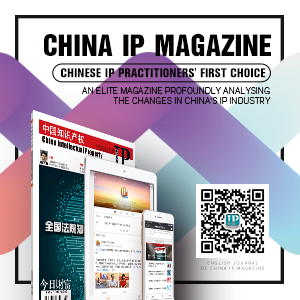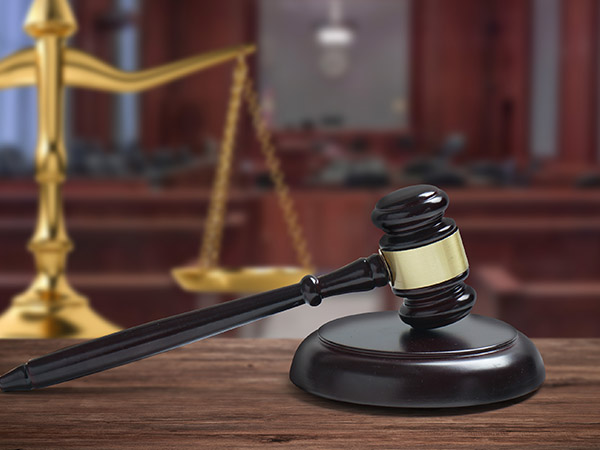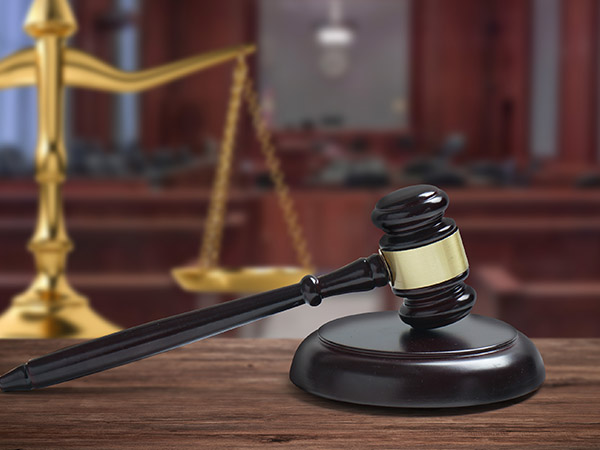Analysis on Issues Related to Amendment of Trademark Law Combined with Judicial Practices
By Rui Songyan, Judge of Beijing Intellectual Property Court
The Trademark Office of State Intellectual Property Office (former Trademark Office of State Administration for Industry and Commerce) issued a notice to launch a new round of amendment of Trademark Law and solicit opinions from the public in March 2018. The current Trademark Law was enacted in August 2013, which streamlined the t r a d e m a r k a p p l i c a t ion procedures, facilitates application of trademark registration, improves the protection level of exclusive right to use trademark, determines trademark use mechanism beneficial to maintaining the sequence of circulation of goods and obtains obvious effect .However, there are some problems after the implementation of the new Trademark Law, such as the phenomena of malicious trademark registration, trademark warehousing and bad faith opposition, which have not been fundamentally curbed. The issues in the current Trademark Law have been analyzed in combination with judicial practices in this Paper to provide feasible suggestions for amendment of the Trademark Law.
I.Article 7: principle of honesty and good faith
1.Issues in Article 7
The principle of honesty and good faith was added in the Trademark Law on amendment in 2013, namely, Articles 7 states:“application for registration and use of trademark shall be in accordance with the principle of honesty and good faith.” The addition in law was favored by the intellectual property law circle in 2013 when the Trademark Law was amended. However, the suggestions to codify the principle of honesty and good faith as an invalidity or opposition provision into the law was not adopted by legislation. Finally, the Trademark Law adopted the principle of honesty and good faith as the general principle to apply for registration and use trademarks, resulting in obstacles to the application of the principle: judge only adopts the opposition of Article 33 and invalidation of Article 44 and 45 in Trademark Law in principle, while the principle of honesty and good faith is not applicable to handling opposition and invalidity cases as it is not specified in these provisions, which is very disadvantageous to curb the improper registration behaviors such as trademark warehousing that may not be adjusted by other terms.At present, only adverse effects (Art. 10, Cl. 1(8) or fraudulent or improper means (Art. 44, Cl. 1) are applicable to trademark warehousing and other behaviors, but their application is hindered. Adverse effects refer to the adverse effect caused by the trademark logo itself. If the trademark itself has no adverse effect, it is not within the scope of the adjustment of adverse effects in principle even if more trademarks are hoarded by malicious hoarders. Fraudulent or improper means apply to invalidity clauses, which are not applicable to preliminary examination and opposition cases by Trademark Office.
2.Suggestions on amendment
Since the expansive construction of the current provisions will cause difficulties in application, the Trademark Law, when amended, should confirm the principle of honesty and good faith as the invalidity and opposition articles, and consolidate them as substantive provisions when conferring trademark rights in the invalidity and opposition articles.
II. Article 10 , Clause 2 : geographical names
1. Article 10, Clause 2 Issues
Article 10, Clause 2 of the Trademark Law provides:“no geographical names of administrative divisions at or above the county level or foreign geographical names known to the public may be adopted as trademarks, except where geographical names have other meanings or constitute part of a collective trademark or certification trademark. Registered trademarks containint geographical names shall remain valid.”The possible problems with this provision as applied may be:
Firstly, geographic names of administrative divisions below the county level and foreign geographic names not known to the public are not included in this provision. Can these geographical names be registered as trademarks? If not, under what provision?
Secondly, under the previous provision, “no geographical names of administrative divisions at or above the county level or foreign geographical names known to the public may be adopted as trademarks”which means these geographical names are not only precluded from registration, they may not even be used as trademarks. Is it rational?
The interpretation of law shall start from the legislative purpose and pursue the legislative intent. The reason why Article 10, Clause 2 is required is that if the geographical names are used as trademarks, the relevant public will consider that they indicate the origin of goods, lack distinctiveness and may not be identified by the relevant public. Therefore, they may not be used as trademarks. Meanwhile, if registration with geographical names is allowed, it will exclude the use by other operators in the same trade and monopolize the interests of geographical names. The geographical names of administrative divisions below the county level or foreign geographical names unknown to the public may not be used for trademark registration as they lack distinctiveness and monopolize the interests of geographical names from the perspective of legislative purpose, while the geographical names that are recognized by the public and thus acquire distinctiveness through long use may be adopted for trademark registration.
Under the current law, although Lijiang Impression, Shanghai Story, Beijing Benz and other brands containing geographical names may be identified by the public as trademarks due to their reputation, these geographic names, as they contain administrative division above county level, such as Lijiang, Shanghai and Beijing, are difficult for registration, unless they have established secondary meanings or the provision is so construed as to be applicable to the trademarks made up of geographical names only. In judicial practices, judges are obviously aware of this problem, and therefore, when applying this provision, they can only try their best to interpret the secondary meanings of the geographical names, or to narrowly apply the this provision in order to reach a fair conclusion. This indicates that there are some problems in this provision as applied.
2.Suggestions on amendment
Actually The provision on geographical names may be incorporated into Article 11 of Trademark Law. According to the contents in Article 11 that “none of the following marks may be registered as trademarks: … (2) where it just directly indicates the quality, principal raw materials, function, use, weight, quantity or other features of the goods; … any mark mentioned in the preceding paragraph may be registered as a trademark if it has acquired distinctive features through use and is readily distinguishable.”Geographical name is a feature of goods, and it is a description of origin of goods. Even if the trademark of geographical name actually does not describe the origin, the relevant public may regard it as the description of origin. The provisions in Article 11 of Trademark Law and the legislative purpose stipulated in the article on geographical names aim at excluding registration of description of features of goods which lack distinctiveness as trademark. Therefore, the above provisions in Clause 2 of Article 10 shall be deleted directly from the Trademark Law on amendment, and the contents of Article 11 shall be amended as “(2) where it just directly indicates the quality, principal raw materials, function, use, weight, quantity or other features of the goods” to better solve the existing problems in articles on geographical name.
III. Provisions on generic names
It is provided in Article 11, Clause 1 (1), of Trademark Law that “none of the following marks that bear only the generic name may be registered as trademarks except those have acquired distinctive features through use and are readily distinguishable.”The issues in the provisions are that whether there is any generic name that is distinguishable through use. There seems to be no such example from everyday experience. For example, mobile phone is a generic name. When the word “mobile phone” appears in a mobile phone, it may not be identified as a trademark to thereby acquire distinctiveness even if it sells well. As this provision of the Trademark Law lacks maneuverability, it is suggested to delete the “generic name” from Article 11, Clause 1(1) of Trademark Law on modification.
IV. Article 13: protection of wellknown trademarks
1. Problems in Article 13
Article 13 of Trademark Law provides for protection of wellknown trademarks , in which Clause 2 deals with unregistered well-known trademarks in the same class, and Clause 3, registered well-known marks in different classes. No substantial amendment was made to the contents of the Trademark Law in 2013. The problems for this provision are:
Firstly, the administrative trademark authorities and the judiciary adopt inconsistent standards as to “mislead the public” in Article 13, Clause 3.
On the provision of “mislead the public” in Article 13, Clause 3 , the Supreme People’s Court has elaborated three detailed situations in Article 9 of the Interpretation of Several Issues Concerning the Application of Law in Civil Disputes involving the Protection of Well-known Trademarks (the Interpretation for Well-known Trademarks): (1) that it weakens the distinctiveness of a well-known trademark, namely dilution of well-known trademarks; (2) that it disparages the reputation of well-known trademarks in the marketplace, namely, the smearing of famous trademarks; (3) that it trades on market reputation of a wellknown trademark. This provision was actually borrowed from EU practice. On the face of it, the three subdivision of the situations is logically repetitive. The dilution and smearing of well-known are viewed from the perspective of objective results, while the trade-on is viewed from the bad-faith intentions to ride on the market reputation of a well-known mark. It seems that the provision “trade on market reputation of well-known trademarks”is redundant. However, it has very important value. In certain cases, the situation in which the trademark registered by the defendant applicant does not dilute or smear the wellknown trademark but the market reputation of well-known trademarks is improperly used really exists. In fact, the provision on “improper use of market reputation of well-known trademarks” is effective means to restraint malicious registration.
Although the Interpretation for Well-known Trademarks is judicial interpretation for civil cases, judges are bound to apply provisions in Article 9 when trying the administrative case related to Clause 3 of Article 13 in order to maintain consistency of judgment standards in judicial practices. However, as the Interpretation of Well-known Trademarks is judicial interpretation, it is not binding on the trademark administrative authorities and does not have to be applied, which may cause inconsistency of applicable standards between the courts and the trademark administrative authorities, resulting in unnecessary waste of administrative and judicial resources. Therefore, how to streamline the applicable standards of trademark administrative organizations and judicial authorities on protection of well-known trademarks is one of the issues to be considered.
Secondly, the issues on dilution of well-known trademarks caused by the trademarks registered for identical and similar goods cannot be solved.
It is only stated in the Clause 2 of Article 13 that “where the trademark of an identical or similar kind of goods is a reproduction, imitation, or translation of another person’s well-known trademark not registered in China and is liable to cause public confusion, no application for its registration may be granted and its use shall be prohibited. However, the similar kind of goods will not be confused but diluted in practices. For example, there are two trademarks in Figure 1. The left one is the trademark in dispute and the right one is LV, a well-known trademark. The two trademarks will not be confused when they are used on leather bags with different selling prices, but the distinctiveness of the right one will be weakened, forming dilution. However, the issues on dilution of similar trademarks are not explicitly stipulated in laws. Therefore, neither Clause 2 nor Clause 3 of Article 13 applies to the cases. The judges may just solve these problems relying on logical interpretation on existing laws. The situation is necessarily solved in the amendment of Trademark Law.

Thirdly, relationship between “Confusion” and “misleading the public” in Clause 2 and 3 of Article 13 is not uncertain.
“Confusion” is used in Clause 2 of Article 13 of Trademark Law, while “misleading the public” is used in Clause 3. From the perspective of legislative technique, the same term shall be used for the same concept in the same law. Therefore, the above “confusion” and “misleading the public” are not the same concept.However, in practices, the distinction between them is not obvious, which brings great trouble to judicial practices. Starting from the intention of the legislators, “confusion”and “misleading the public” here shall be a concept with the same meaning and shall be unified in the amendment of law.
2.Suggestions on amendment
Based on the above discussion, the terms “confusion” and “misleading the public” are unified on amendment of Trademark Law. Meanwhile, the three situations of “diluting, smearing and improper use of market reputation”shall be explicitly stipulated, of which dilution includes diluting the similar trademarks.
V. Article 30 and 31: rejecting application for trademark regitration and prior application rule
1. Issues in Article 30 and 31
Only the serial number rather than the contents of Article 30 and 31 is amended when the Trademark Law was amended in 2013. The issues in Article 30 and 31 lie in whether the confusion serves as judgment standard of trademark registration.
Article 30 and 31 only refer to the identical or similar goods and trademarks rather than confusion, which results in that the judges need to read the confusion elements into Article 30 and 31 when applying laws. Applicable law is usually based on the relevant and similar regulations in the Interpretation of Several Issues Concerning the Applicable Law for Trying Civil Trademark Disputes of Supreme People’s Court (Interpretation), the logic used in which is that “a trademark is similar when it is likely to cause mistake,and “a good or service is similar when it is likely to cause confusion.” Logically, a good or service will not be confused even if it is similar with other, such as mineral water and cola, tables and chairs. Consumers will not confuse the above goods. The reason for this regulation in judicial interpretation is not that the developers are not clear about this logical relationship, but they need to take into account the confusion elements, otherwise it will violate the basic principles of Trademark Law. The situation indicates that no regulations on confusion elements in cases of trademark invalidity and opposition will bring obstacles to the application of laws.
In addition, another important reason for clearly stipulating confusion elements in the above provisions is that, in addition to the identity and similarity of goods, identity or approximation of trademarks, some other factors will affect judgment of confusion such as features and location of goods.Figure 2 shows the importance of features of goods for judgment of confusion. The right one is the trademark in dispute; the left one is a reference mark. They have a degree of approximation. In this case, the features of goods cannot be ignored in the consideration of confusion.Since both trademarks are registered on watches, it is difficult for consumers to notice the difference in details between the two marks, so the above degree of approximation is easy enough to lead to confusion.

Region factors are also important for judgment of confusion. The trademarks Binwang ( 宾王) and Luo Binwang ( 洛宾王) as shown in Figure 3 have a certain degree of approximation. Since Luo Binwang is a well-known poet in the Tang Dynasty, the public usually does not confuse it with Binwang based on the perception of meaning. However, it is easy to identify the possibility of confusion in the consideration of the fact that the trademark applicants of the two marks and the owner of the reference mark are all in Yiwu, Zhejiang, and that Binwang in Yiwu, Zhejiang is equal to Luo Binwang.

Therefore, it is less than rational under the current law to treat identicalness or similarity of the marks, or of the goods or services,as the registrability criteria, and therefore it is necessary to add
the resulting confusion as an examination element..
2. Suggestions on amendment
Article 30 shall be adjusted as “where a trademark, for the registration of which an application
is made, that does not conform to the relevant provisions of this Law or that is identical with or
similar to the trademark already registered by another person or is given preliminary examination
and approval for use on the same kind of goods or similar goods,may easily lead to confusion, the
Trademark Office shall reject the application and shall not publish that trademark”; and Article 31
shall be adjusted as “where two or more applicants apply to register identical or similar trademarks for use on the same kind of goods or similar goods, which may easily lead to confusion, the Trademark Office shall first conduct examination of, give approval to and announce the trademark whose registration is applied for earlier than the rest. Where the applications are filed on the same day, the Trademark Office shall first examine, give approval to and announce the trademark which is used earlier that the rest, and it shall reject the applications for registration of the other trademarks and shall not publish them.” in accordance with the provisions of Article 57 when the Trademark Law is amended.
VI. Article 57: infringing exclusive right to use registered trademark
1. Issues in Article
57 Article 57 of Trademark Law is a civil protection clause for exclusive right to use registered trademark, and its issues are reflected in two aspects: Firstly, it is provided in Article 57, Clause 1 that where a person, without permission from the owner of a registered trademark, uses a trademark that is identical with the owner’s on the same kind of goods, he infringes the exclusive right to use registered trademark. The reason why there is no clear confusion elements may be that the same goods and the same trademark are usually considered to be confusing. In fact, there may be no confusion in particular cases. A more typical example is the OEM processing. Although OEM technically is use of trademarks, it will not cause the relevant public confusion and thus not constitute infringement as the OEM products are not sold in China. It can be seen that in the case of the same goods and trademark, it is not without consideration of confusion, but only presumptive confusion. If there is counterevidence that may overturn this presumption, it should still be determined that there is no possibility of confusion. It is an important difference between Clause 1 and 2 of Article 57. Secondly, there is no provision on infringement of well-known trademarks. Protection of wellknown trademarks is one of the important parts of civil trademark protection system. Although the judges may judge the infringement of well-known trademarks through civil judicial interpretation, the administrative law enforcement of trademarks lacks the legal basis to solve the infringement of wel l - known t radema rks . Therefore, consideration shall be given to improving the clause on infringement of well-known trademarks on amendment of the Trademark Law.
2.Suggestions on amendment
Firstly, the Item 1, Clause 1, Article 57 may be regulated as “where a person, without permission of the owner of a registered trademark, uses a trademark that is identical with the owner’s on the same kind of goods, which may easily lead to confusion.” Secondly, the provisions in Item 2 of Article 1 and Article 2 of Interpretation, and Article 9 “diluting, smearing and improper use of market reputation” of Interpretation of Several Issues Concerning Well-known Trademarks are included in the Trademark Law as the infringement rule of wellknown trademarks.
VII. Clause 3 of Article 59: defense of prior use of trademark
1. Problems in Article 59, Clause 3
The defense clause of prior use in Clause 3 of Article 59 is newly added on amendment of Trademark Law in 2013. Issues in this clause are to judge whether the defense of prior user right is applicable to the defendant’s behavior. Meanwhile two times points shall be considered, namely the date for application of the plaintiff’s trademark and the date of actual use by the plaintiff. In other words, the date when the defendant uses trademark shall not only be earlier than the application date of the trademark owner but also earlier than the date when the trademark owner uses the trademark, so as to exclude the cases that the defendant is malicious. If only the application date is taken as the standard, it is possible that the defendant may use the plaintiff’s trademark for the purpose of free riding after the trademark obtains certain popularity through use. If only the application date serves as the time point of prior use defense, the malicious use by the defendant may be deemed to meet the requirements of prior use defense and thus may not be effectively stopped. However, the provisions in Clause 3 of Article 59 may also affect some bona fide trademark users. In some cases, the defendant did not know that the plaintiff had used the trademark. Generally, this kind of coincidence occurs more easily when the original defendant is far away and the trademark is an existing word. At this point, although the defendant uses the trademark later than the plaintiff, he/she is not malicious subjectively. It is obviously not reasonable that the defendant’s behavior is still deemed to constitute infringement. I n t h e amendment o f t h e Trademark Law, the provisions on the date of use may be considered to be deleted, and the date of application shall still serve as the time point for judgment. However, in order to prevent malicious defense, the provisions that the defendant may prove no malicious intent shall be added, so as to better solve the problem of “punishing the innocent.”











